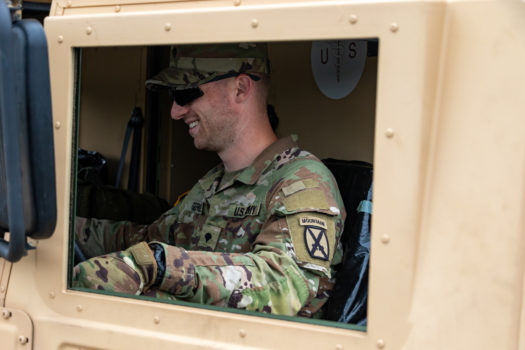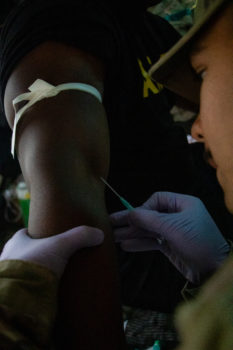
As the summer begins, Soldiers from Fort Drum and Fort Polk assist Fort Knox Soldiers in a mass casualty training event prior to the arrival of the 2022 Cadet Summer Training (CST) Cadets. At ten o’clock a.m. the call came through telling the medical team that Soldiers with simulated burns and bus roll over injuries are in need of evacuation. A line of four medical trucks are equipped with; a map, a radio, a list of injuries and equipment needed for them roll out to triage and load up the victims. In charge of communicating this information is Sgt. Timothy Patterson, the truck commander for the first med truck on scene. Patterson relays information to the Role 2 Field Hospital, civilian ambulances, range control, and the MedEvac helicopter. The victims are then brought back to the medical site for further care. The evacuation area is fitted with a Role 2 tent, where the patients are treated, and an outpatient tent where they wait for evacuation to the University of Louisville Hospital.
Patterson stated that although this is a training event for the Soldiers it is still important to do things by the book. “The biggest thing that everyone needs to keep in mind is that this is real world injuries, they should treat this as real world,” said Patterson, “a lot of times you have these repetitive training exercises and people don’t take it seriously, there’s ‘oh another training let’s get through it and we’ll go home’ but…you really don’t understand how difficult that is until you have to do it in real life,” he continued.

The MARCHH algorithm helps them when caring for trauma patients in these situations. MARCHH stands for massive hemorrhage, airway, respiration, circulation, hypothermia and head. According to Spc. Mikelle Thompson, they learn how and when to follow this sequence. For instance, if there were an obvious penetrating head wound, a medic would start with the last H, for head, not with M.
Whether the Soldiers were nervous or excited about the training it offered an opportunity to build a flow. Important to building a team flow is communication, the one thing about the drill that Thompson felt was lacking from the day, “Communication is probably the only piece that I thought didn’t go well,” she said.
Other Soldiers felt that this drill provided an opportunity to learn. U.S. Army Spc. Daniel Sandoval, of CST team black, stated that even though he felt comfortable with his abilities in the field he was excited about the training value of the drill, “It’s been a minute since I’ve been in the back of the FLA (field litter ambulance), [it] feels good to be back,” said Sandoval.




